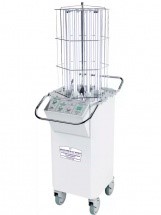Catalog

RII MNPO SPEKTR
25 products
View:
Telephone number:
E-mail:
mail@niiin.ru
Website: http://www.niiin.ru
Address:
Russia, Moscow, null, 35 building.1null
Сайт:
http://www.niiin.ru
Адрес:
Russia, Moscow, null, 35 building.1null
- Selected: 0Applying
- Selected: 0Names
- Selected: 0Manufacturer
- Selected: 0Made in
- Selected: 0Additional
View:
24 products
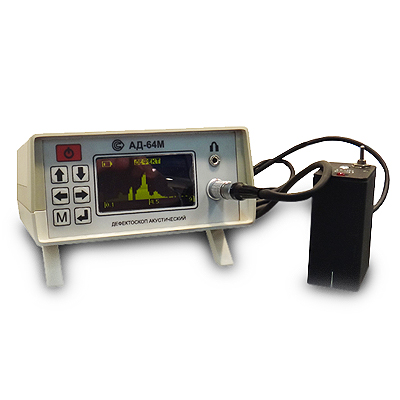
AD-64M Acoustic Impedance Flaw Detector
from
715 855 ₽
Control methods: Impedance method (IM) and free oscillation method (MSC)
Distinctive features:
- A wide range of controlled materials: from steel to foam and structures with soft external and internal elements
- Application of two complementary control methods
- One-way access
- Dry contact of the transducers with the controlled object
- Visual representation of information
- The ability to memorize and reproduce the setting modes, which excludes the use of control samples at the workplace
Technical specifications:
The minimum area of the detected defect, cm2: 1
The depth of detected defects in fiberglass, mm: up to 12...15
Light and sound signaling of defects
Number of measurements per second: 15
Weight, kg: 1
Self-powered by batteries
Continuous battery life, h: 8
Operating temperature range, °C: -10...40
RII MNPO SPEKTR
Moscow
Produced in: Moscow
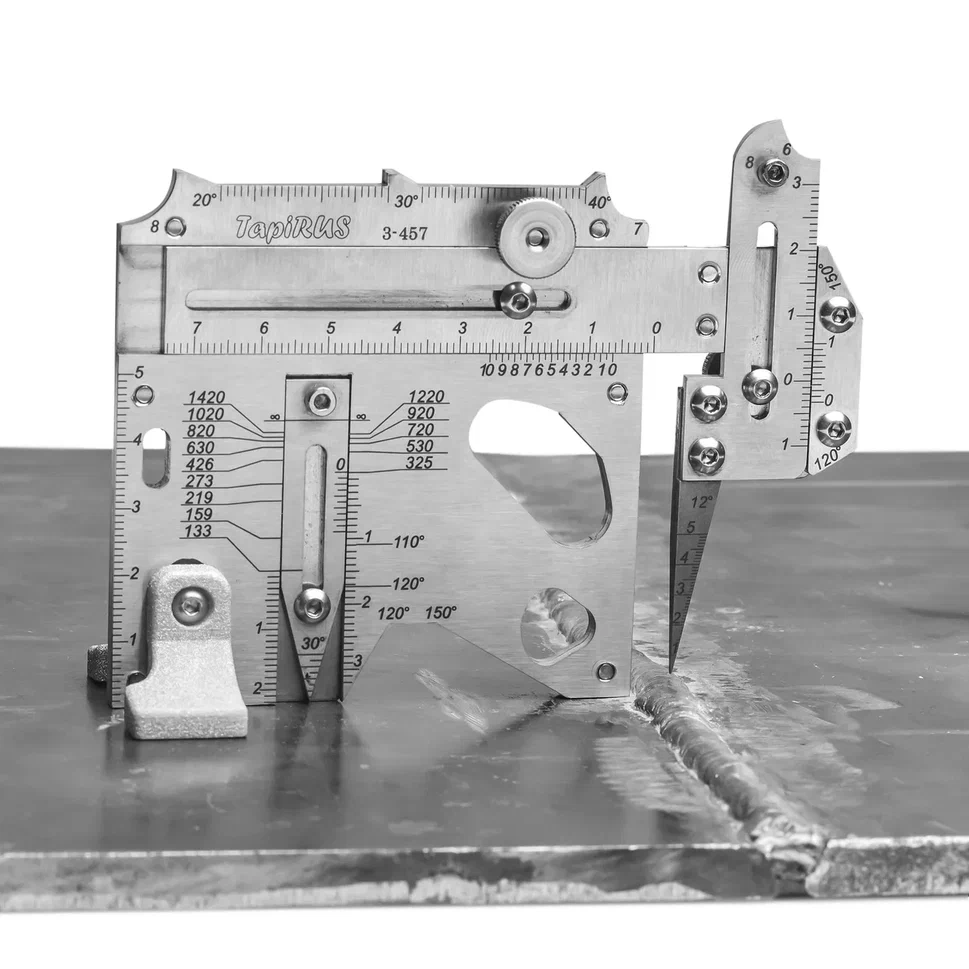
UShS "Tapirus" with cover and supports
from
18 000 ₽
The UShS TapiRus is designed to replace numerous templates and devices used in visual and measuring quality control of welded joints. It is approved as a means of measuring the geometric parameters of welded joints and surface defects during visual and measuring control (VIC) and supplied with verification. It allows you to determine most of the geometric parameters of welded joints and surface defects: the width and convexity of the seam, the depth of the cut, the amount of edge displacement, the angle of the angular seam, the angle of the bevel and the gap, etc. Equipped with supports that allow you to uniquely position the template on a curved surface. To carry out measurements with an error of 0.1 mm, scales with a vernier are applied to the TapiRUS surface. It contains a number of gauges for assessing the smooth transition from the deposited to the base metal, the size of the cathets, radii and angles of cutting edges. Equipped with a probe with a replaceable measuring needle to determine the size of gaps and heights / depressions.
The development, preparation for production and manufacture of TapiRus were carried out exclusively in digital format.
The latest laser and additive technologies are used in the production of TapiRUS:
high-precision laser cutting machines in inert gas;
five-axis CNC machining centers;
ultra-precise color laser engraving of the entire product assembled;
laser stereolithography (SLA) is a technology of layer–by-layer synthesis of a material from a liquid photopolymer.
Advantages
Easy to install. Accurate positioning along the normal to the surface of the object of control and stability of the position when performing measurements.
Functionality. Measurement of most geometric parameters of welded joints and surface defects.
Measurement accuracy. The measurement error on the template scales does not exceed 0.1 mm.
Modernity. Online calculator ergonomic accessories smart version.
More detailed information can be found on the website tapirus.info
MEASURED PARAMETERS AND DEFECTS
VIC at the stage of input control
wall thickness
depth of corrosion ulcers on the base metal
the depth of corrosion ulcers on the weld
the depth of scratches (risks), a bully on the base metal
edge bevel angle
the amount of blunting
geometric parameters of the dent
VIC during assembly (preparation for assembly)
edge offset
withdrawal (angularity) of edges
the gap in the cutting
the height of the potholders
angular displacement
VIC in the welding process (surfacing)
edge offset
height of the root (filling) layer
withdrawal (angularity) of edges
angular displacement
VIC of finished welded joints (structures)
edge offset
angular displacement
the height of the reinforcement of the seam
the height of the bulge (when welding elements of different thickness)
the width of the reinforcement of the seam
withdrawal (angularity) of edges
the depth of the sinking between the rollers
incomplete filling of the cutting edges
scaliness of the seam surface
smooth transition
undercut depth
seam crater depth
technical specifications
Measured parameter Scale Range,mm Error, mm
Depth, mm H 0...20 ±0.1 (in the range 0...10 on), ± 0.5 (in the range over 10...20)
Height, mm H 0...6 ±0.1
Width, mm W 0...55 ±0.1 (in the range 0...10 on), ± 0.5 (in the range over 10...20)
Clearance, mm N 0...5 ±0.1
Dullness, mm F, G 0...25 ±0.5
Specifications
Overall dimensions, mm, no more
(without supports) 115x85x15 ± 0.5
(with supports) 115x85x42 ±0.5
Average time to failure, cycles,
at least 55,000
Weight, kg, not more than 0.22
Average service life, at least 1 year
RII MNPO SPEKTR
Moscow
Produced in: Moscow
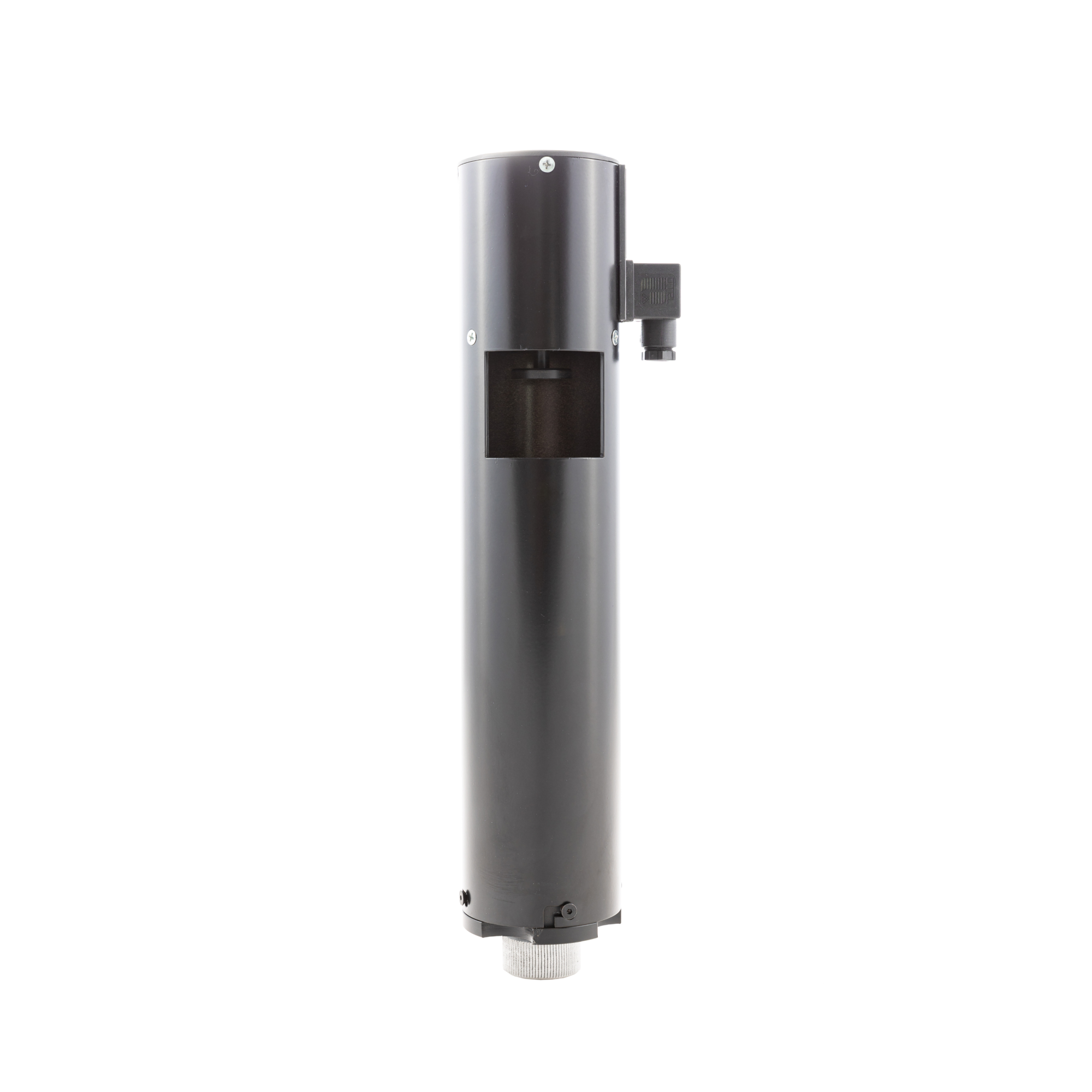
CD-1 Paint detector of defects 220V
from
50 000 ₽
The principle of operation:
The controlled extended product (pipe, rolled or wire) is passed through the working area of the flaw detector. When a defective area is detected, the flaw detector included in the automated system sends a signal to trigger the paint meter actuator, as a result of which the paint from the marker's aerosol can is applied to the surface of the controlled product through a window in the device housing.
Features and benefits:
- Any standard aerosol cans with a diameter of 68 mm can be used in the flaw detector;
- Easy replacement of the cylinder;
- The device does not require connection to the pneumatic line;
- High performance;
- The design of the CD-1 defect meter allows connection to any standard AC and DC electrical networks with rated voltages from 12 to 380 V.
Scope of application:
The CD-1 automatic paint sprayer is an auxiliary equipment and is used in conjunction with flaw detectors as part of in–line automated lines for marking defects in quality control of extended products made of various materials, ferrous and non-ferrous metals and alloys - welded, hot-rolled and cold-drawn pipes, rolled products, wire and products made of them.
The flaw detector can be used both in the production process and during input control on the consumer side at machine-building, transport, chemical and oil and gas enterprises.
*Custom-made versions for rated voltages can be of: 12, 24, 48, 110, 127, 220, 380V.
RII MNPO SPEKTR
Moscow
Produced in: Moscow
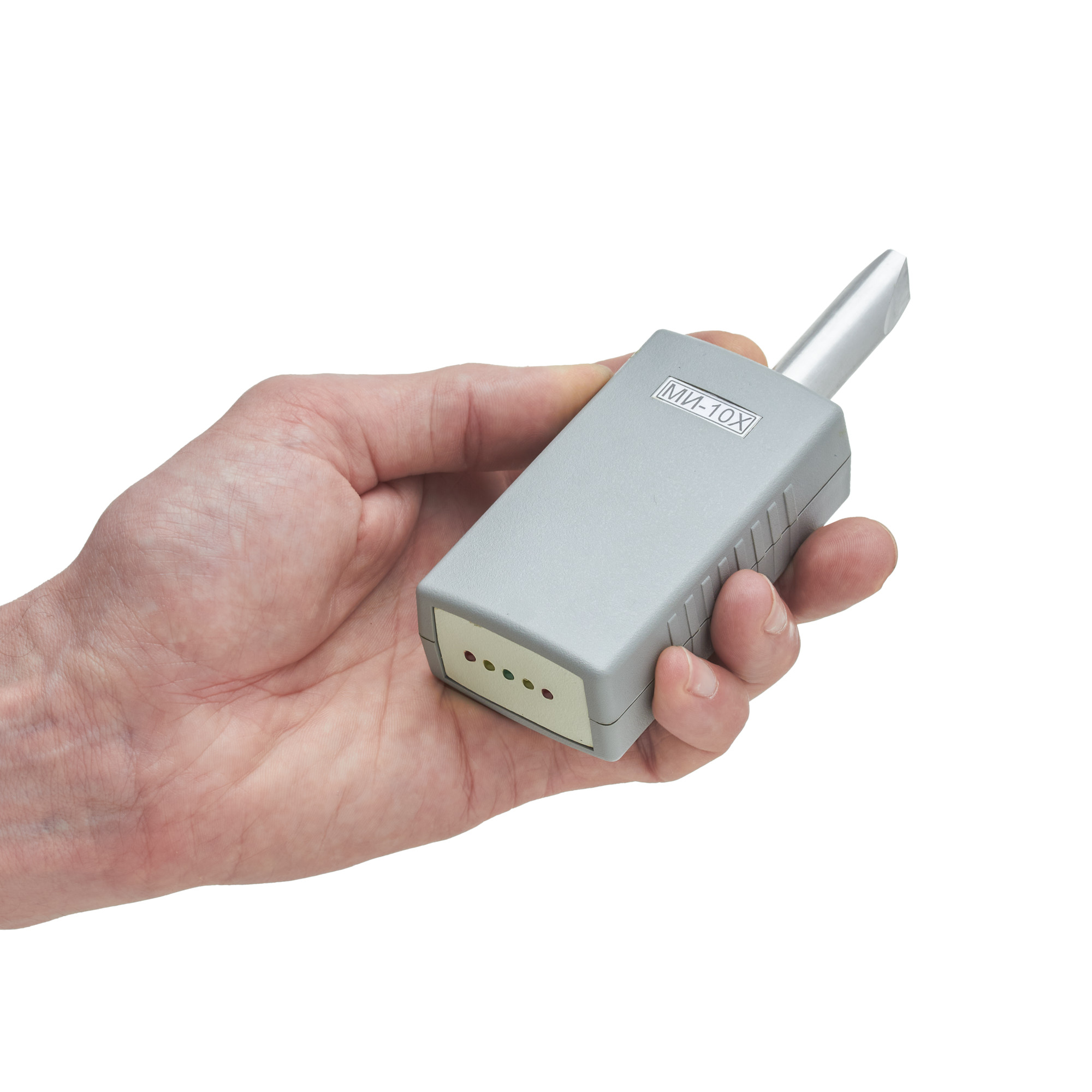
MI-10X Magnetic Indicator
from
17 000 ₽
Distinctive features.
Compactness
Autonomy
Maximum ease of handling
Energy saving mode
Technical specifications
Indication of induction levels, MT,:
weak magnetization 0...2
average magnetization 2...10
strong magnetization more than 10
Power supply 1 accumulator unit or PP3 battery
Current consumption, mA, no more than 8
Operating temperature range, °C -30...+50
Dimensions of the electronic unit, mm 90x50x32
Dimensions of the converter, mm 14x50
RII MNPO SPEKTR
Moscow
Produced in: Moscow
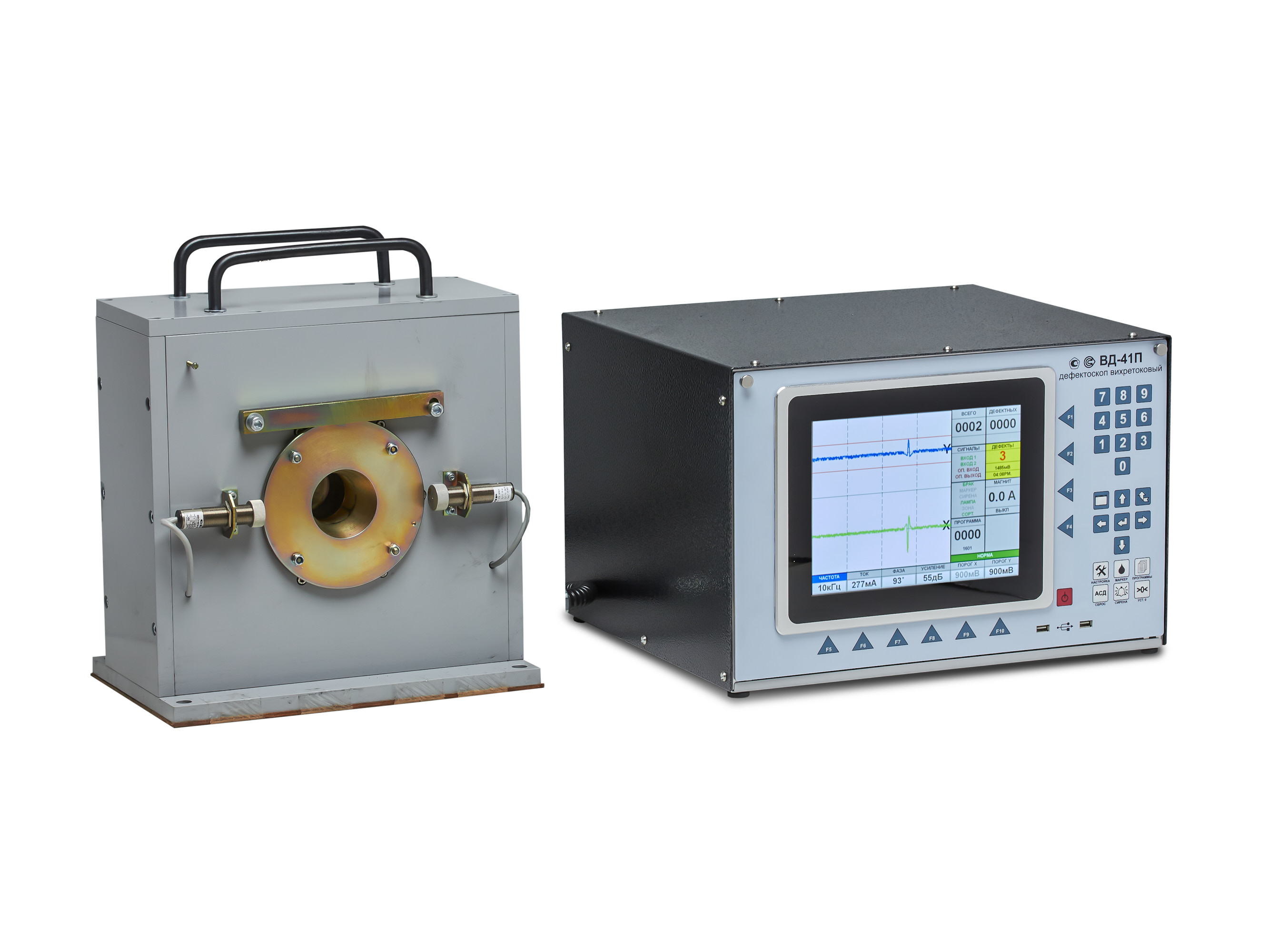
VD-41P Eddy Current Flaw Detector
Scope of application
The VD-41P eddy current flaw detector is designed to work as part of automated quality control lines at pipe-rolling and metal-rolling enterprises with continuous output control of products together with other auxiliary devices: a paint meter, a path sensor, an object presence sensor, an automatic sorter, a demagnetizer.
The device can also be used for input control at machine-building enterprises of the automotive, aviation, oil and gas, and agricultural industries.
Technical specifications:
Control frequencies: 1.0 – 100 kHz.
Control speed (line speed): 0.5 - 5 m/s.
The high-frequency filter is automatically adjustable depending on the speed.
Signal phase adjustment: 0 - 359° .
Converter current adjustment: 50 – 500mA.
Automatic monitoring of the operability of the measuring converter.
Data processing:
- Software adjustable filter.
- Signal evaluation using signal masks:
- circular mask,
- sector masks.
- Sorting by control results.
Display: 10.2” (26 cm) touch LCD (800x600).
Operating system used: WINDOWS® 7.
Dialog language: Russian, other languages (optional).
Applicable eddy current converters: overhead type, through type, sector type.
Interfaces:
- Connector for the converter unit.
- External automation control connector.
- 4 outputs with delay adjustment - "dry contact".
- 2 external information inputs.
- VGA interface for connecting an external monitor.
- USB 2.0.
- Network: Ethernet (TCP/IP).
- Other interfaces on special order.
Power supply: 220 V, 50 Hz.
Operating temperature range: 0 to +40°C.
Type of climatic performance - UHL 4 (i.e. for moderate and cold climate).
Enclosure protection degree: IP 53.
Dimensions, w/h/d: 471 x 285 x 460 mm / can be built in a 19” rack/cabinet.
Weight: approx. 20 kg.
RII MNPO SPEKTR
Moscow
Produced in: Moscow
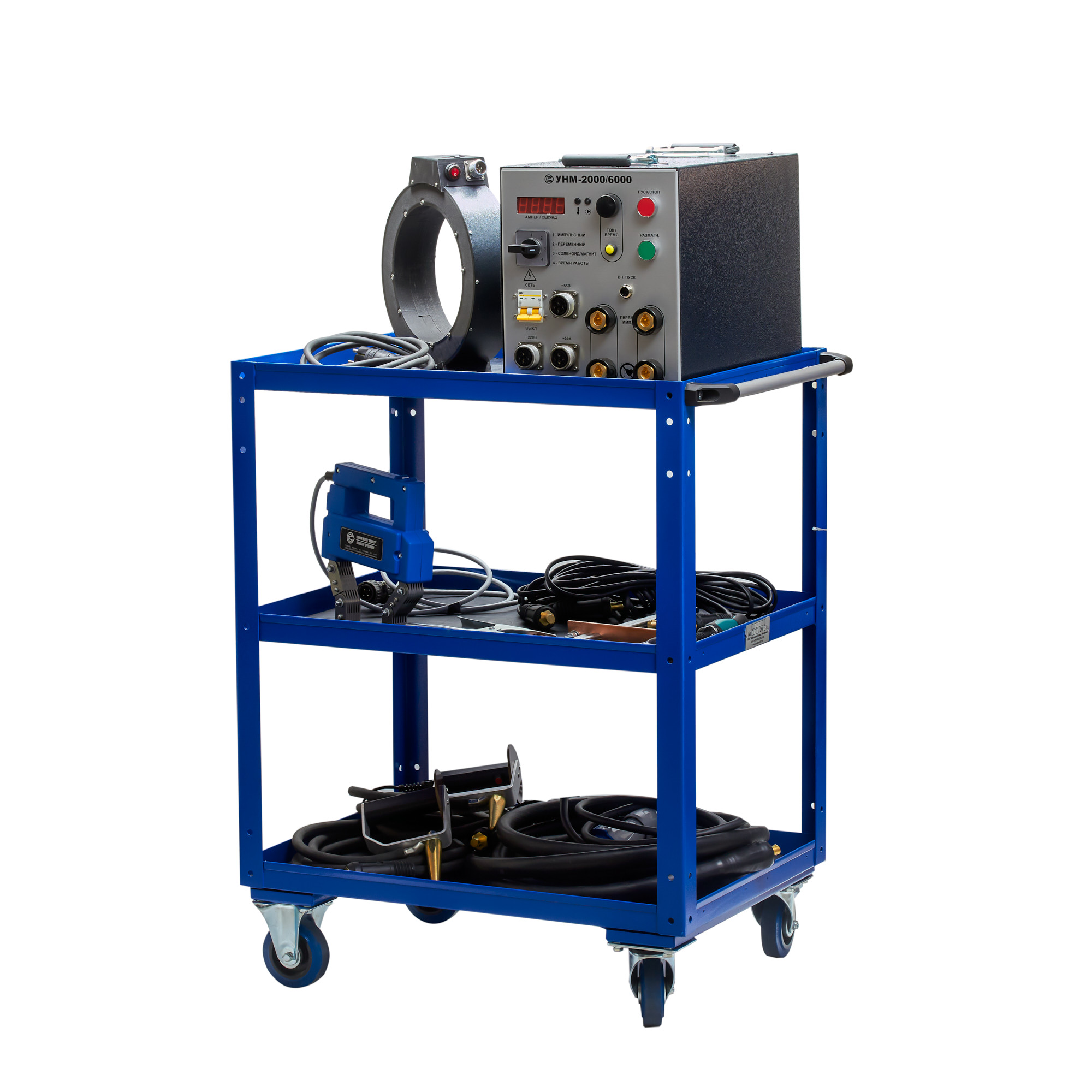
UNM-2000/6000 portable magnetizing device
The principle of operation of the means of magnetic particle control
The portable device UNM-2000/6000 of the MANUL series is a magnetic particle flaw detector that provides measurements by the applied field method and the residual magnetization method using direct, alternating and pulsed current with specified parameters. External magnetizing devices included in the kit (solenoids, electromagnets, contact devices for connecting cables) allow for longitudinal, transverse and circular magnetization of the object under study.
A special magnetic powder, dry or in the form of an emulsion, is applied to the controlled surface. Inhomogeneities of the magnetic field in the places of defects lead to the accumulation of powder particles, thus "showing" a hidden picture.
Design features and advantages of the UNM-2000/6000 powder flaw detector:
In the MANUL series, the UNM-2000/6000 device is capable of providing the highest magnetization current (up to 6000 A in pulse mode), which allows you to control products having a large mass or size, as well as those made of magnetohard alloys;
The device can be included in automated quality control stands: there are network interfaces (LAN, Bluetooth, Wi-Fi) for connection; microprocessor control provides storage and reproduction of magnetization and demagnetization parameters, logging of control results, automatic demagnetization;
The design is modular, allows for changes to implement the individual wishes of the customer;
It fully complies with the following standards: GOST R 56512-2015, GOST R 53700-2009 (ISO 9934-3:2002), GOST R 50.05.06-2018, GOST R ISO 10893-5-2016, GOST ISO 17638-2018 , RD 34.17.102-88, RD-13-05-2006 and other Russian and foreign standards regarding the requirements for magnetizing devices and magnetic particle flaw detectors;
It is approved for use by industry regulatory documents, in particular, by the Russian Railways.
Scope of application
Magnetic powder control devices are widely used in various industries, construction and transport, from steel and pipe rolling plants to organizations engaged in the operation and repair of machines, mechanisms and vehicles. Magnetic powder flaw detectors belong to the means of non-destructive testing and therefore can be used to detect defects in products and structures operating under pressure, including at chemical and oil and gas industry enterprises, as well as during the operation of pipelines.
In particular, devices for monitoring by the magnetic powder method have proven themselves well at Russian Railways and metro enterprises engaged in the operation and repair of rolling stock, including for the control of shafts, wheels and wheel pairs, gearboxes, springs, couplers and other loaded components and parts.
Technical specifications:
Magnetization currents:
Variable,
Pulse,
Rectified (only for solenoid and electromagnet)
The measurement error of the magnetization current is no more than 10%.
Characteristics of the pulse current:
The repetition frequency of unipolar current pulses during magnetization and of multipolar current pulses during demagnetization is (2 ± 0.2) Hz.
The duration of the current pulses is at least 1.5 ms.
Magnetic characteristics of the solenoid:
The maximum alternating magnetic field in the center of a single solenoid is at least 100 A/cm.
The maximum alternating magnetic field on the axis in the center between two solenoids located at a distance of 200 mm is at least 60 A/cm.
The maximum permanent magnetic field in the center of a single solenoid is at least 80 A/cm.
The maximum permanent magnetic field on the axis in the center between two solenoids located at a distance of 200 mm is at least 50 A/cm.
Values of magnetization currents:
The maximum alternating magnetization current in the unwound cable is 6 m × 50 mm2 and on the electrical contacts is at least 2000 A.
The maximum pulse magnetization current in an unwound cable of 4 m × 10 mm2 and on electrical contacts is at least 6000 A.
The current adjustment range in the solenoids and the electromagnet is from 0.5 to 4.5 A.
Characteristics of the electromagnet:
The maximum alternating magnetic field in the air gap of the electromagnet depending on the interpolar distance is as follows:
- in the 140 mm gap: at least 75 A/cm;
- in the 40 mm gap: at least300 A/cm.
The maximum constant magnetic field in the air gap of the electromagnet depending on the interpolar distance is as follows:
- in the 140 mm gap: at least 100 A/cm;
- in the 40 mm gap: at least 400 A/cm.
Operating mode:
The operating mode is cyclic: magnetization/pause.
The magnetization time is adjustable from 1 to 40 s.
The demagnetization time is adjustable from 5 to 60 seconds.
Demagnetization of parts is performed automatically.
The time of setting the operating mode is no more than 15 seconds.
The duration of continuous operation is at least 8 hours.
Power supply parameters:
The device is powered by an AC power supply with a voltage of 220 V and a frequency of 50 Hz.
The power consumed from the network is no more than 5 kVA.
Overall characteristics:
Overall dimensions of the device (w × h × d) – no more than 267×245×465 mm.
The weight of the device is not more than 50 kg.
Other characteristics:
The average worktime before failure is at least 12500 hours.
The average recovery time is no more than 6 hours.
The average service life of the device is at least 10 years.
Сompliance with standards
The device fully complies with the requirements of GOST R 56512-2015, GOST R 53700-2009 (ISO 9934-3:2002), GOST R 50.05.06-2018, GOST R ISO 10893-5-2016, GOST ISO 17638-2018, RD 34.17.102-88 and RD-13-05-2006 in terms of the requirements for magnetizing devices and magnetic particle flaw detectors.
Identification of the load.
It performs automatic identification of the types of connected load: cables, solenoids and electromagnet.
Control of the connected load current
It allows you to control the current of the connected AC/DC electromagnets and solenoids.
The kit includes:
1 Electrical contact with cable, cross section 50 mm2, length 3m
2 Solenoid cable, 3m long
3 Solenoid cable, 0.5m long
4 Magnetizing cable, cross section 10 mm2, length 6m
5 Magnetizing cable, cross section 50 mm2, length 6m
6 Solenoid - 2pcs
7 The electromagnet is manual
8 Trolley
9 Power unit UNM 2000/6000
RII MNPO SPEKTR
Moscow
Produced in: Moscow
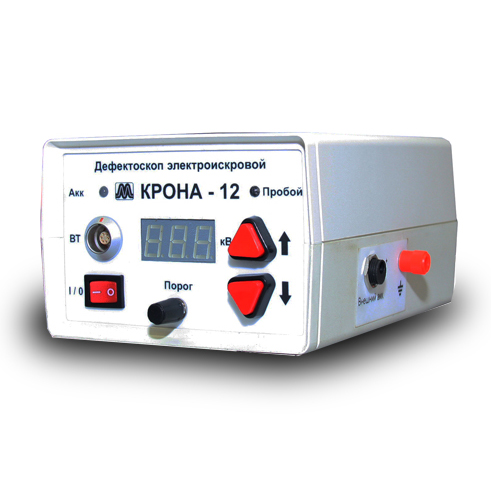
KRONA-12 Electric spark flaw detector
from
430 000 ₽
The flaw detector allows continuous monitoring of polymer, epoxy and enamel coatings of pipelines with a diameter from 219 to 1420 mm and selective control of polymer, epoxy, enamel and bitumen coatings of pipelines of any diameter.
The flaw detector provides detection of local through defects of insulation coatings of pipelines with a dry surface.
The flaw detector allows for continuous monitoring
The flaw detector uses an electric spark control method.
The flaw detector is designed to work at:
- ambient temperature, °C: from minus 30 to plus 50;
- relative humidity at a temperature of +25°C, %: 98;
- atmospheric pressure, kPa: from 84.0 to 106.7.
Technical specifications.
Test voltage, kV: up to 40
Minimum diameter of detected defects, mm: 0.6±0.2
Operating temperature range, °C: -30...+50
Power supply
-from the built-in 12V battery
-from an external DC power supply
current with a voltage of 12 V
Continuous operation time, h: 8
Operating mode setting time, min: 1
Overall dimensions, mm, no more:
- control and monitoring unit 200 x 158 x 91
- high voltage transformer 410x f90
Weight, kg, no more,:
- control and monitoring unit 2.5
- high voltage transformer 1.5
Defect alarm light and sound
The kit includes:
Bag
Suitcase
Battery charger
Earthing device
Electronic
Magnet Unit
Probes for continuous monitoring- 5 pcs
0 – 400 mm; 1 – 650 mm;
2 – 735 mm; 3 – 840 mm;
4 – 980 mm.
Probes for local control - 3 pcs
VT-1 High voltage transformer
Pin
Probe extension
Holder
Bushing
Nipple - 4pcs
set of documentation (passport, manual, calibration)
RII MNPO SPEKTR
Moscow
Produced in: Moscow
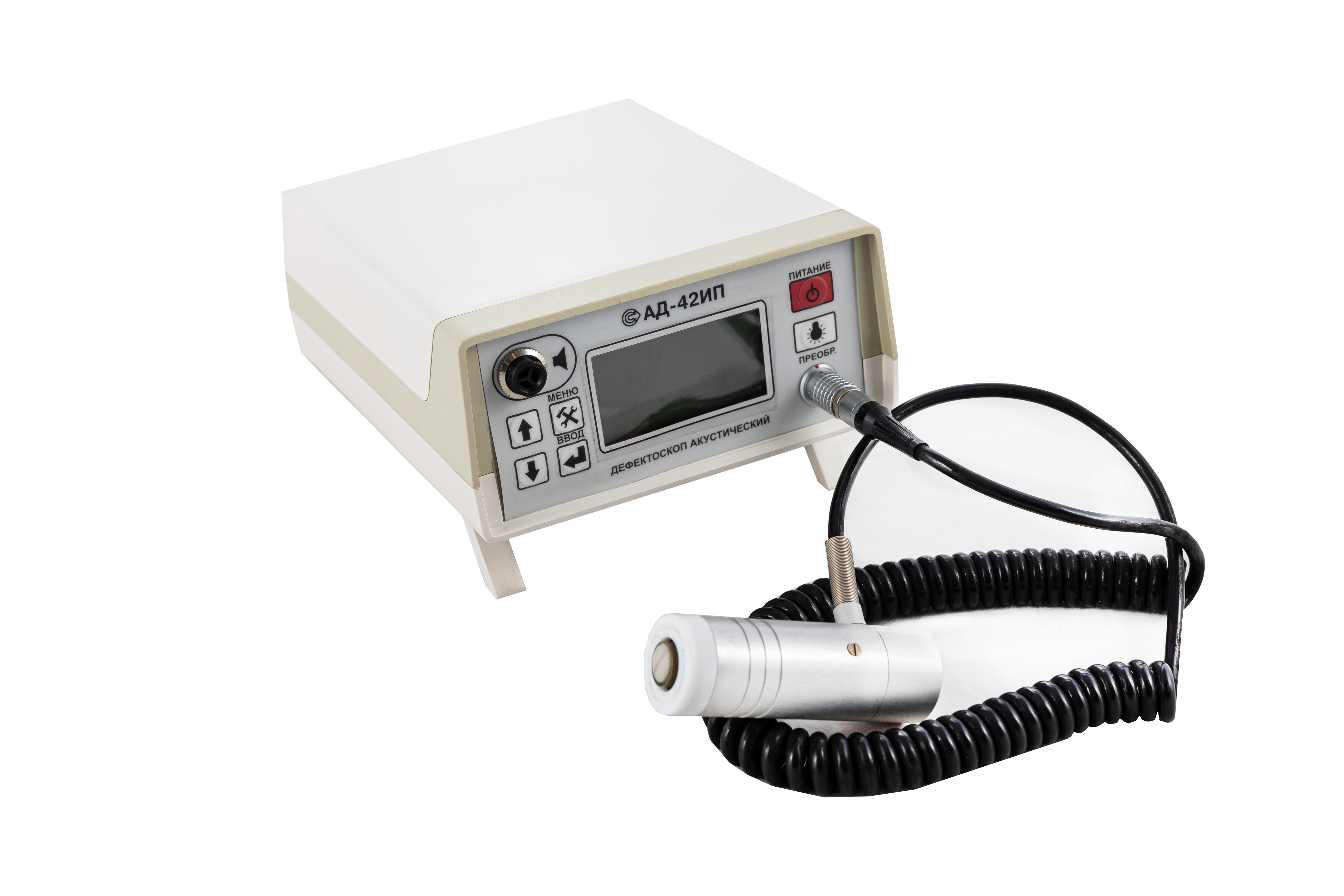
AD-42IP Acoustic Flaw Detector
from
383 500 ₽
It is especially effective for use in products made of composite materials (including with honeycomb filler).
Distinctive features:
The AD-42 IP is a compact acoustic system sensitive to changes in mechanical impedance caused by product defects. The indication of the device indicates that there are voids, non-adhesives, delaminations or changes in the structure of composite materials (including with honeycomb filler and laminated plastics) under the sensor.
The device is used to monitor various materials and their combinations.
The energy consumption of the unit is low because the converter is switched on when the sensor is placed on the monitored product.
Being light enough, the device allows you to perform monitoring in hard-to-reach places or in confined spaces.
The results of the control can be stored in the built-in non-volatile memory and transferred to a PC.
Converters
Options: - 3 types of converters for various tasks
Emitters: - 1 or 2 on each converter
Switching-on: - The converters are switched on when they are placed on a controlled object.
Technical characteristics:
Weight, kg: 0.73
Dimensions, mm: 210x150x70
Power supply: 4 AA batteries
Work without recharging the battery, h: 8
Battery discharge visual indication
The defect alarm is visual on the converter and audible on the instrument panel (or) in headphones.
RII MNPO SPEKTR
Moscow
Produced in: Moscow
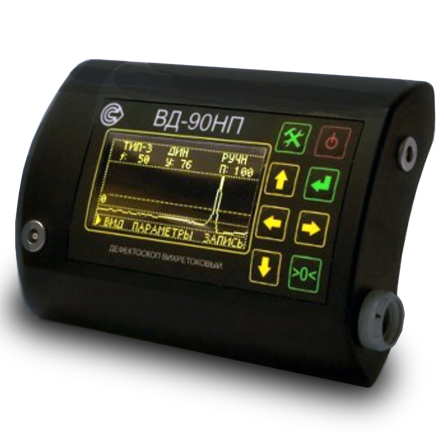
VD-90NP Eddy current flaw detector in the basic configuration
from
295 000 ₽
The principle of operation of the device:
The principle of operation of the flaw detector is based on the excitation of eddy currents in the controlled product and the subsequent release of a signal at the output of the converter, the amplitude and phase of which are determined by the secondary field of eddy currents.
Design features and advantages of the VD-90NP flaw detector.
The device has a small-sized case, which ensures its lightness, ergonomics and allows you to mount it on your belt or on your arm. The measurement is performed using a remote converter connected by a flexible cable. There are several types of converters for eddy current flaw detection of products made of different materials and different geometries. The large and bright display displays the selected operating modes and measurement results in text and graphic form. The VD-90NP is also characterized by:
high sensitivity (it detects cracks starting from 0.1 mm in size);
dust–and-moisture-proof housing, which makes it applicable for work in the field;
large operating frequency range;
maximum working clearance up to 10mm;
Bluetooth connection;
the ability to control products with high surface roughness, up to Rz320 class;
light and sound indication of defect detection;
wide operating temperature range from –30°C to +50°C;
autonomous low-voltage power supply;
long continuous operation time from one set of batteries;
compliance with the standard GOST R ISO 15549-2009 (ISO 15549:2008).
The use of a microprocessor-based hardware and software platform provide it with the following operational characteristics:
automatic adjustment when measuring conditions change, including compensating the influence of the gap;
built-in calibration modes;
saving the measurement results in the internal memory of the device;
a large number of stored programs: sets of parameters and measurement modes, both preset and saved by the user so as to repeatedly monitor the same type of products;
The Bluetooth 2.0 wireless communication module allows the device to be used in conjunction with an external laptop or mobile device for remote control, transmission of measurement results for further storage, printing, documentation and analysis.
Scope of application:
The eddy current method is suitable for non-destructive testing and detection of microcracks in products and parts made of any metals and alloys of complex shape, with high surface roughness, through non-conductive coatings, as well as for checking welded joints. The flaw detector can be used to control parts and assemblies of aviation equipment.
The VD-90NP eddy current flaw detector is used for quality control and preventive examination of:
- components and parts of rolling stock at railway transport enterprises: wheel sets, auto coupler housings, side frames, spring beams, labyrinth rings, pulleys;
- pipes, profiles, rods at rolling mills at the output control, and at the input control of consumers of products;
- products made of aluminum and titanium alloys with multilayer coatings at enterprises of the aviation and aerospace industry;
- cables, beams, critical components of equipment (cranes, lifts) in construction;
- main pipelines in order to detect stress corrosion.
A wide range of operating temperatures, dust and moisture protection (IP54 degree of protection), autonomous low-voltage power supply, a long time of continuous operation of the device allows it to be used in the field at low temperatures and under precipitation (rain, snow).
Basic kit:
• 1 electronic unit for the VD-90NP eddy current flaw detector;
• 1 Ia5.125.052 (Type-2) eddy current converter;
• 1 converter cable;
• 1 charger with batteries;
• 1 hand strap;
• 1 Ia8.896.104 sample with artificial defects;
• 1 Ia8.896.035 coating sample;
• 1 storage and carrying case;
• 1 documentation set.
RII MNPO SPEKTR
Moscow
Produced in: Moscow
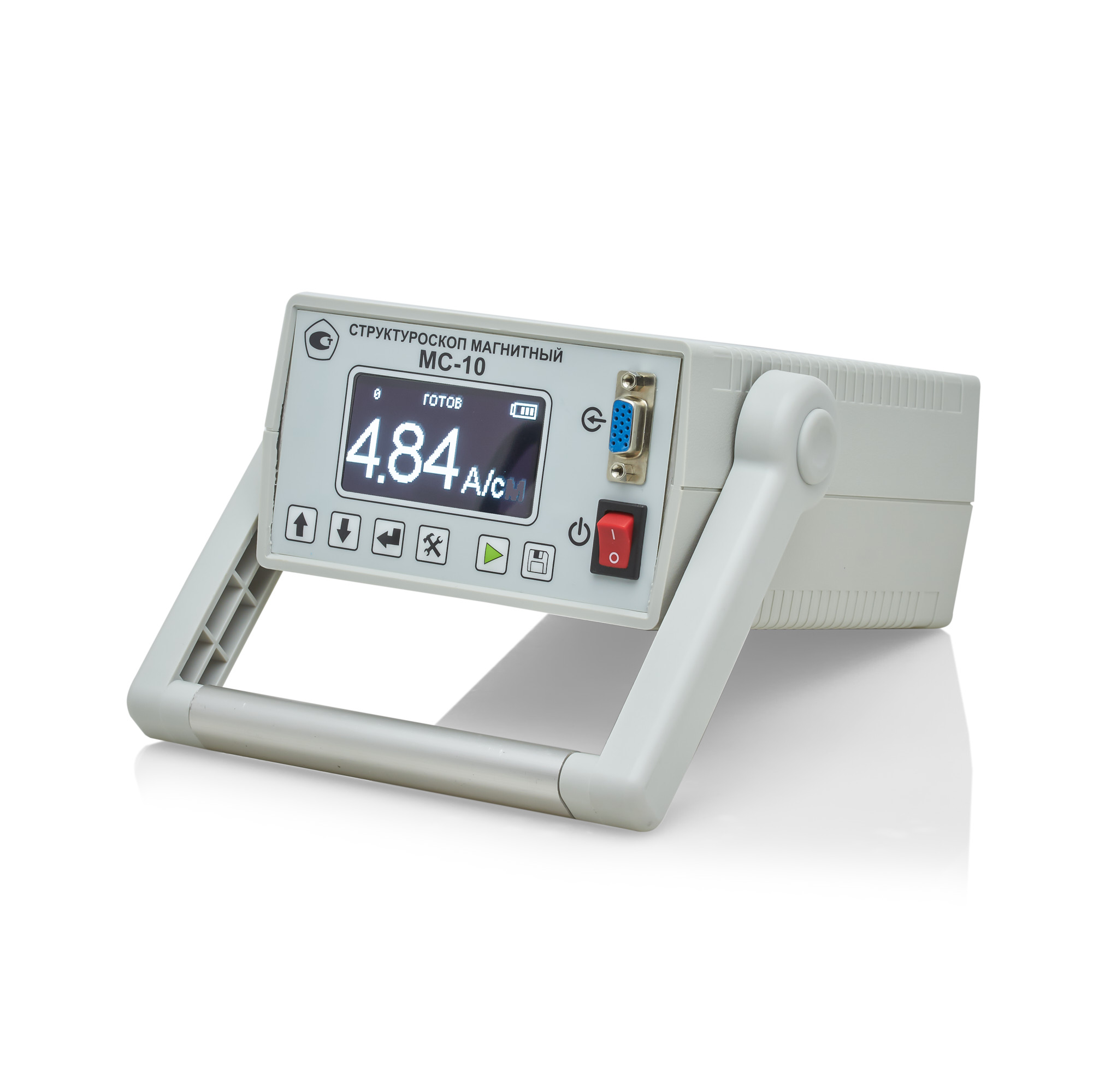
MS-10 Magnetic Structuroscope
from
270 000 ₽
Distinctive features:
- Non-destructive testing of strength, plasticity and viscosity of parts and structures made of ferromagnetic steels and cast iron according to the following standards: GOST 30415-96, OST 14-1-184-65, TU-14-1016-74
- Non-destructive testing of the depth and hardness of surface-hardened layers on steel and cast iron parts;
- Quality control of low-temperature tempering of cutting and measuring tools, bearing steels;
- Control of uniaxial elastic stresses;
- Control of the uniformity of the properties of massive parts.
Technical specifications:
The range of coercive force of the material of the controlled products, A/cm, is 1.0...60.
The limit of the permissible basic absolute error of measurements of the coercive force (Ns) on standard samples at a normal ambient temperature of 20 ± 5°C does not exceed the values of 0.1+0.04 Ns
(Ns stands for the measured value of the coercive force of the standard sample).
This error probability is provided with a gap between the converter and the surface of the controlled product not exceeding 0.5 mm.
Basic version: The structroscope is powered by a battery.
Extended version: It is possible to work on 220V/50Hz grid.
The time of setting the operating mode after power on, min: no more than 2
Time of one measurement, sec: no more than 6
Continuous operation time (without recharging), h: at least 16
Internal memory: up to 512 series of 512 measurements each with the possibility to view the results
Operating temperature range: -20°C to +40°C;
Overall dimensions, (length x width x thickness), mm:
electronic unit: 190x140x80
converter: 135x75x100
Weight, kg:
the electronic unit with a battery: 2.3 ± 0.05
the converter: 1.3± 0.05
Basic version kit:
Ia5.173.023 Electronic unit: 1 pc.
Ia5.125.061 Converter: 1 pc.
Ia8.896.121 Control sample of coercive force (plate PN-1): 1 pc.
Ia8.896.122 Control sample of coercive force (plate PN-2): 1 pc.
Bag-case: 1 pc.
Charger: 1 pc.
Ia2.778.042 RE Operating Manual: 1 copy.
Ia2.778.042 FO Form: 1 copy.
Ia2.778.042 MP Verification instructions: 1 copy.
Extended version:
Additionally, it can be equipped with a Bluetooth® module for communication with a PC and software for receiving and processing data.
It can also be equipped with a small-sized converter.
RII MNPO SPEKTR
Moscow
Produced in: Moscow
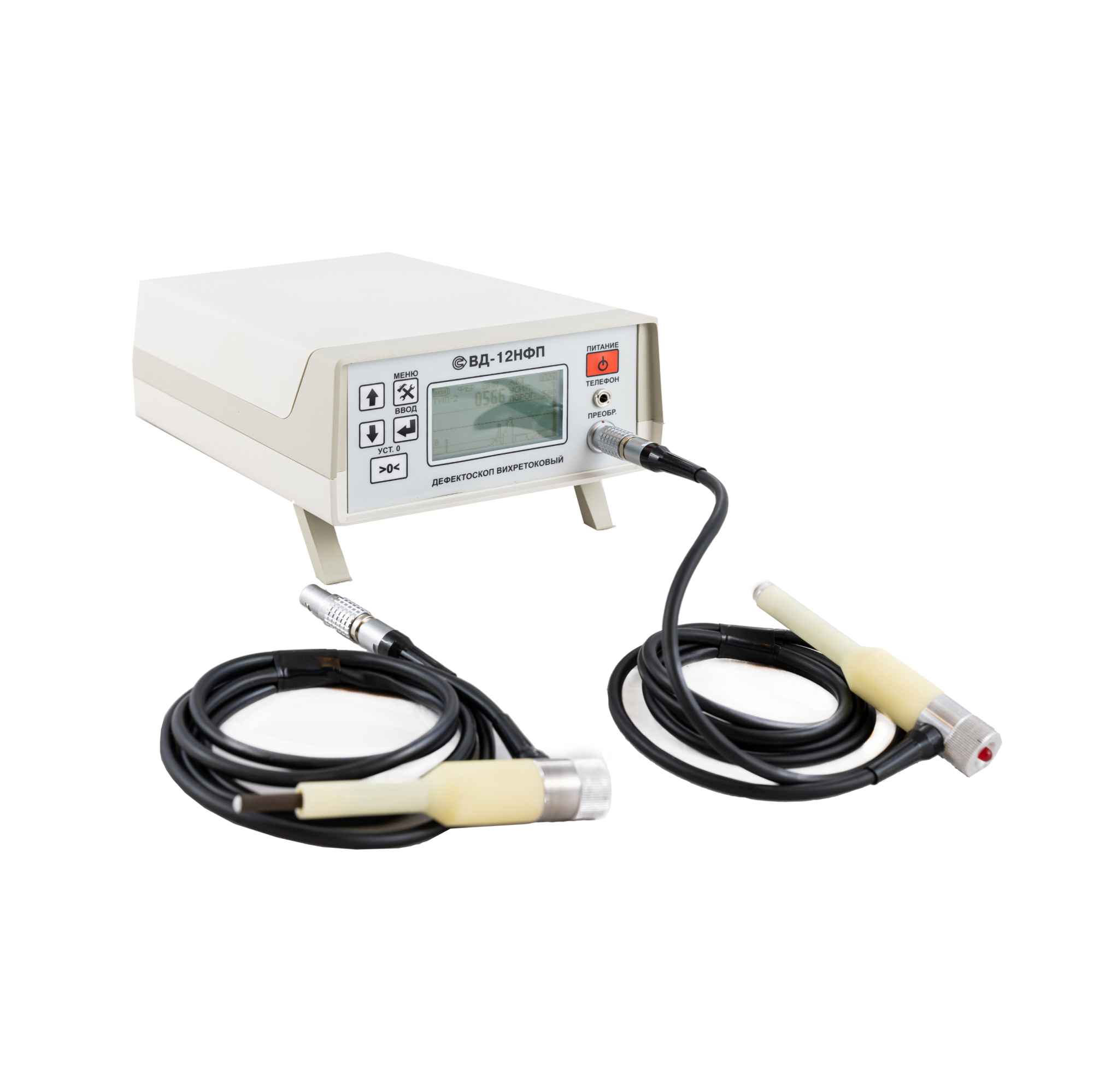
VD-12NFP Eddy Current Flaw Detector with 2 converters
from
254 000 ₽
The device allows you to detect surface defects like cracks, visualizing the signal from the continuity interruptions on the display. The design of the flaw detector allows to determine with high reliability the exact location and depth of defects even on rough surfaces of flat and curved shape, including under a layer of corrosion or in the presence of a protective coating of the controlled area of the product with a thickness of up to 3 mm.
The principle of operation of the VD-12NFP eddy current flaw detector:
The principle of operation of the VD-12NFP eddy current flaw detector is based on the phenomenon of electromagnetic induction. An alternating magnetic field created in the primary coil of the converter by means of a sinusoidal voltage generator excites eddy currents in the controlled product. A parasitic magnetic field formed by eddy currents at the locations of defects affects the measuring unit (two signal coils connected in series) of the converter, creating an electromotive force in it. The amplitude and phase of the secondary signal carries information about the properties of the defect and the position of the transducer relative to the surface of the controlled product. The output signal from the measuring unit of the converter, after amplification and processing using a microprocessor, is displayed on the readout of the device, and is also stored in the memory block for subsequent transmission to a personal computer. In addition, information about the defects is displayed on a piezoelectric bell used as an audio indicator.
Design, features and advantages of the VD-12NFP eddy current control device:
The VD-12NFP eddy current flaw detector is a portable device capable of working both in a desktop and in a suspended position in a special bag-case. This ensures convenient operation of the device in a variety of conditions: in the laboratory, in the factory shop or during field tests. The flaw detector consists of an electronic unit with controls and display of test results, as well as three replaceable converters with wear-resistant corundum tips connected to the electronic unit using a connector. The choice of the desired converter depends on the magnetic properties of the material. For the control of parts with grooves, a converter with an inclined tip is offered. The device is powered by 4 AA batteries located in the battery compartment of the electronic unit.
The advantages of the flaw detector include:
- a screen for visualizing the signal during measurement;
- light weight and compact dimensions that allow you to use the device in almost any conditions;
- the ability to control the quality of products of various curvature and surface roughness even in the presence of a protective coating or a layer of corrosion;
- wear resistance of converters, which is important when monitoring products with increased surface roughness (up to Rz£320);
- automatic detection of the type of converter when connected, as well as the presence of built-in memory for storing control results;
- the possibility to transfer data to a personal computer for storing or printing control protocols.
Scope of application:
Portability, high productivity, the ability to work with curved and rough surfaces, as well as the fact that the operation of the flaw detector is practically unaffected by humidity, pressure and contamination of the gas environment or the surface of the controlled product with non-conductive substances ensure the versatility of the device for detecting cracks in various materials.
The eddy current flaw detector VD-12NFP is actively used in heavy industry for diagnostics of metal structures, assemblies and mechanisms for various purposes in factory workshops or laboratories, including at enterprises of railway transport, automotive industry, mechanical engineering, pipelines and metal structures.
The VD-12NFP flaw detector can be used with equal success in the field, factory workshops, depots, laboratories and workshops to monitor the current condition, as well as to assess the degree of wear, the possibility and duration of further operation of such products made of metals and alloys as over-spring beams, wagon wheels, auto coupler housings, side frames, wheel couples and others.
Distinctive features:
• control of parts with surface roughness up to Rz320 due to wear-resistant corundum tips;
• assessment of the degree of danger (depth) of the defect;
• automatic detection of the converter type;
• microprocessor control;
• 5 universal programs for saving settings;
• capable of detecting defects with a depth of 0.3 mm
• The angle of deviation of the converter from the normal to the working surface up to 60°
• Operating frequency of 70 kHz;
• Maximum working clearance of 3mm;
• visualization of the signal from the defect;
• built-in memory for storing control results
• Equipped with a Bluetooth 2.0 wireless communication module, which allows you to transmit control results and control the flaw detector at a distance of up to 20m;
• The possibility of forming a control protocol based on the data transmitted to the PC;
• Temperature range from 0°C to +40°C;
• The design allows you to work with the flaw detector without removing it from the bag-case.
Basic kit:
Ia5.173.016: 1 electronic unit
Ia5.125.031: 1 converter, type 1; marked as (•)
Ia5.125.030: 1 converter, type 2; marked as (••)
Ia2.706.002: the KOIDZ-VD set of samples with a passport (consisting of:
Ia8.896.034: 1 piece;
Ia8.896.035: 1 piece;
Ia8.896.035-01: 1 piece) - A certificate of verification.
4 AA batteries
1 charger
1 small-sized phone
1 CD with software
1 special key
1 bag-case
A calibration certificate is issued for the VD-12NFP flaw detector.
1 passport
1 operating manual
1 calibration instruction
RII MNPO SPEKTR
Moscow
Produced in: Moscow
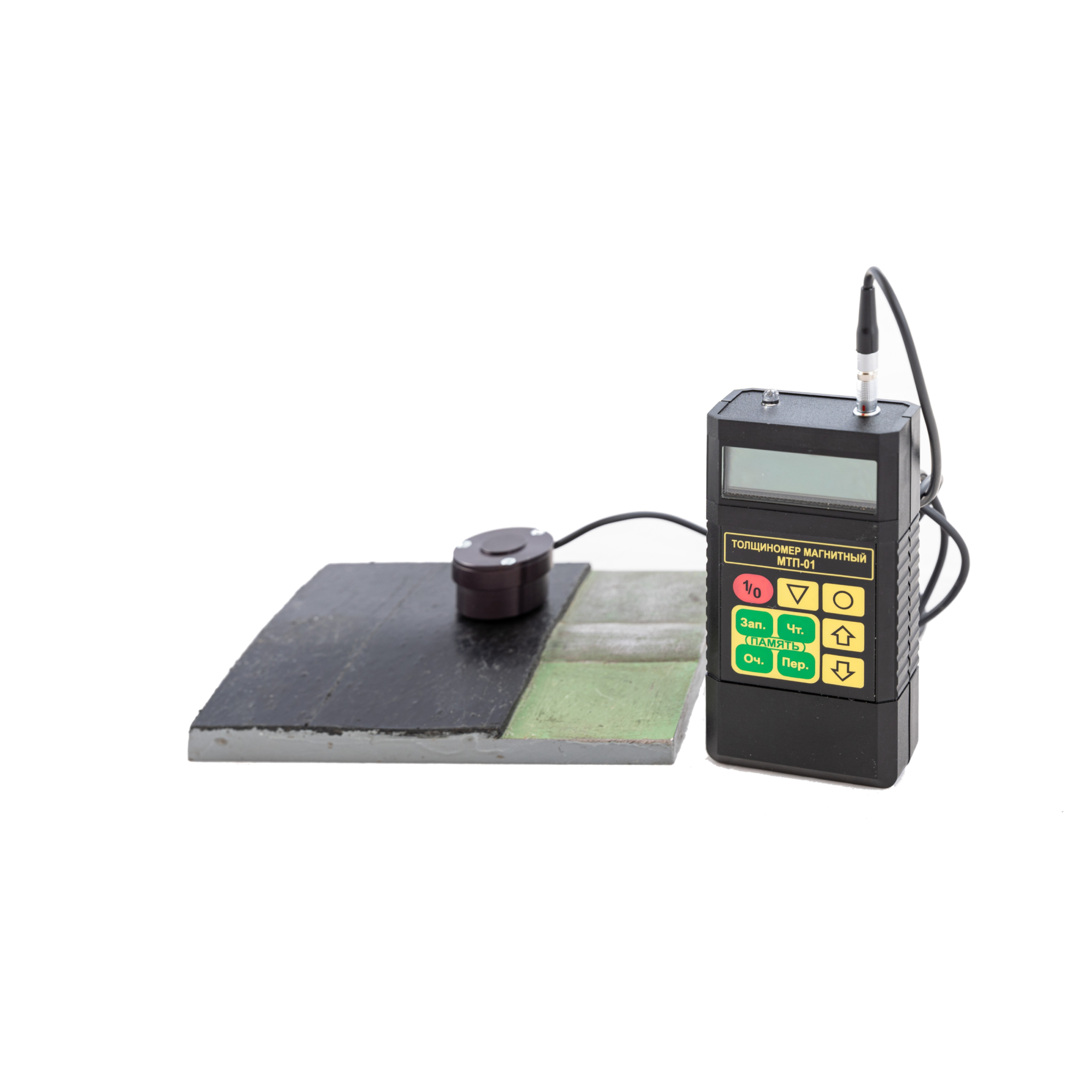
MTP-01 Magnetic Coating Thickness Gauge
from
75 000 ₽
Measuring range of thickness of protective coatings, mm: from 0.2 to 10
Digital display of measurement results: yes
Power supply: from a PP3 type
battery with a voltage of 9V
Power consumption, MW: 100
Operating mode setting time, min: 1
Time of one measurement, sec: 3
Memory capacity, number of thickness values: 2000
Overall dimensions, mm:
- electronic unit (width-depth length) 120x60x25
- measuring transducer (diameter height) 33x23
- connecting cable (length) 1500±300
Weight, g, no more:
- electronic unit (without battery power) 80
- measuring converter 40
The kit includes:
- Electronic unit,
- Measuring converter
- Plate made of non-magnetic material for setting the upper limit of measurements
- Battery type PP3
- CD-ROM with the program
- Prism
- Cover
- Spring
- Case
- Passport
- Operation Manual
RII MNPO SPEKTR
Moscow
Produced in: Moscow
